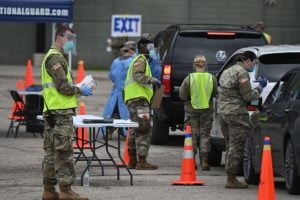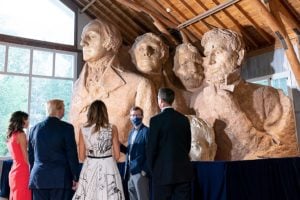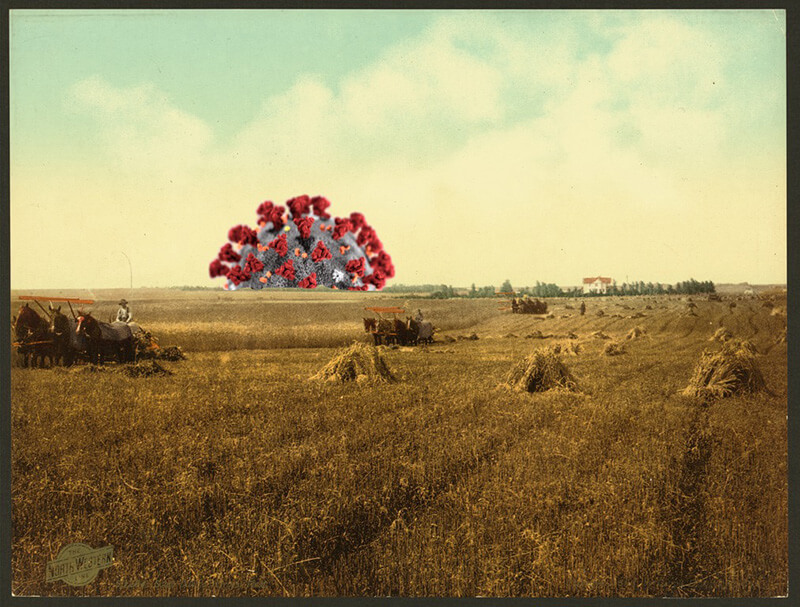Earlier this week, North Dakota’s Kailee Leingang spoke to Slate about being a contact tracer in a state where the global COVID-19 pandemic has killed around one in every 800 people.
Asked about the resistance she often faced when contacting virus positive residents, the University of North Dakota nursing student recalled one particular patient.
“They were not happy with me at all,” she says. “They didn’t think that this was a big deal [and] didn’t think that they needed to be concerned. It was a cold. It was just a virus.
“And then things progressively got worse, that’s where it came in: OK, this might be real. The constant calling and questioning of, Is this OK? Should I go in? Should I go in? Should I go in?
We have some of the highest numbers in the world. If we don’t take some action, it’s only going to get worse.
“Unfortunately, eventually they did go in, and they didn’t leave the hospital alive.”
While the pandemic’s first two waves hit the United States with ferocious intensity earlier this year, the current surge is already shaping up as something far nastier.
According to a recent USA Today analysis of Johns Hopkins University data, 45 out of America’s 50 states recorded more cases during a week in November, than any other week during the pandemic. The month saw one in every 76 Americans test positive for COVID-19.
Inflamed by politicized public health messaging, especially around the use of masks, those living in North and South Dakota are amongst those suffering the most in the U.S right now.
By mid-November, North Dakota had the worst COVID-19 mortality rate in the world, beating every other nation state. South Dakota had the third worst.
Beyond the raw numbers, the COVID-19 experience in the two states is indicative of the larger pain being felt by rural and minority populations this year. As of yesterday, 60 out South Dakota’s 66 counties were listed as having “substantial” community spread of COVID-19, while large Native American populations of both states have suffered proportionally far more than their non-indigenous neighbors.
With potential cold chain issues dogging coming vaccine distribution in rural areas, and holiday gatherings almost certain to give the pandemic fresh legs, the approaching six months look tough for the Dakotas.
“Our numbers are awful,” Dr. Shannon Emry, a Sioux Falls, South Dakota pediatrician, told the Associated Press last month.
“We have some of the highest numbers in the world. If we don’t take some action, it’s only going to get worse.”
‘Screw Covid, I Went To Sturgis’
As of today, a total of 81,955 positive cases have been recorded in North Dakota, with 995 dying from COVID-19. South Dakota’s numbers are comparable, with 84,398 cases and 1064 deaths.
Combined, the overall figures for the two Dakotas are incredibly close to those of Japan, where 2289 have died from COVID-19 and 156,789 have been infected by it. More than 126 million people live in Japan, while less than 1.7 million live in the Dakotas.

With 10,754 positive cases per 100,000 North Dakotans, and 9540 per 100,0000 in South Dakota, the two states have the worst, and second worst, overall infection rates per capita in the U.S. Though the tide has gone out a little recently, daily average deaths per 100,000 people over the last week also see both states at top of America’s COVID-19 pile.
Speaking to USA Today, Dr. Ali Mokdad, a professor at the Institute for Health Metrics and Evaluation at the University of Washington in Seattle, compared the Dakotas’ November numbers to that of war-torn countries.
“How could we allow this in the United States to happen [?],” Mokdad says. “This is unacceptable by any standards.”
South Dakota reported its first case of COVID-19 on March 10, with North Dakota announcing one the following day.
Though school closures quickly followed, months of relatively low positive cases—spread over a combined area larger than that of Germany—meant North and South Dakota weren’t exposed to the pandemic’s reality the way those in the Northeast and Southeast initially were.
Over time, both states—both led by conservative governors and state governments—continued to enjoy far looser rules around travel restrictions and self-isolation, than most. Few events have summed up COVID-19 indifference like early August’s notorious motorcycle rally in Sturgis, South Dakota.
Around 460,000 people headed to Sturgis for the 10-day event, which received the green light from Governor Kristi Noem. Social distancing and mask usage was limited, while t-shirts were printed, declaring ‘Screw Covid, I Went to Sturgis.’
How could we allow this in the United States to happen [?] This is unacceptable by any standards.
Though it is now impossible to know exactly how much of a COVID-19 ‘super-spreader’ the rally really was, positive cases are understood to have spread to more than 20 states, with at least 300 people infected. A significant outbreak in Minnesota is thought to be sparked by bikers returning from Sturgis.
Dr. Shankar Kurra, Vice President of Medical Affairs for South Dakota’s Monument Health, told KOTA TV that the rally was South Dakota’s COVID-19 real ‘inflection point.’
“We saw the change a couple of weeks after the rally in the middle of August, August 24th roughly, and then we saw a steady climb ever since,” Kurra says.
“We don’t know if we’ll ever know the full extent [of the spread],” Dr. Benjamin C. Aaker, president of the South Dakota State Medical Association, told the New York Times.
“These people go home and get sick with coronavirus. They don’t have any way of knowing whether they picked it up at the rally or back in California.”
A muted response
With numbers peaking in mid-November, North Dakota Governor Doug Burgum finally instituted a statewide mask order, on November 14. In the following fortnight, Covid-19 positive cases decreased by an incredible 57 percent in North Dakota.
Criticism still rages at Burgum’s handling of the pandemic response, which includes a loophole that could see asymptomatic, COVID-19 positive healthcare workers forced back to work.
Though county officials have implemented mask rules for urban areas in South Dakota, it still stands as one of a handful of U.S. states who still haven’t, on a state-wide level. Governor Kristi Noem has staunchly defended her lack of a mask order, saying it is up to the people to decide.
Like their neighbors, South Dakota—which reported 1050 new positive cases yesterday—has seen overall numbers decrease since November. Underlying statistics reveal the existing extent of the problem, however.

A shocking 47 percent of South Dakota’s Covid-19 tests are currently coming back positive, trailing only Idaho for worst rate in the U.S. The World Health Organization (WHO) says a region’s positive percent rate should “ideally” be under five percent.
South Dakota’s healthcare system is straining too, with a 37-hospital network recently sending COVID-19 patients home with oxygen tanks to open up more beds for incoming. On December 2, one of South Dakota’s largest hospitals announced it was down to 6.7 percent free ICU beds. COVID-19 are now regularly being sent out-of-state.
Though a vocal supporter of President Donald Trump, Noem’s hands-off pandemic approach has seen even the White House become critical of her state’s COVID-19 status.
“Given the extraordinarily high test positivity and incidence, among the highest in the world,” a White House pandemic task force report noted, on November 22, “aggressive measures to limit additional hospital overruns and preventable mortality are warranted and strongly recommended.”
Despite making up only nine percent of the state’s population, South Dakota’s Native Americans account for 14 percent of its cases, and 15 percent of its deaths. A disproportionate amount of its indigenous people have had to recover from, or be treated for, COVID-19, in makeshift hospitals.
If people don’t hear about that and they don’t talk about that, nothing is ever going to be done. Nothing’s ever going to be understood.
“My experience dealing with COVID-19 in South Dakota is one of failed leadership,” Nancy Babbitt, a physician providing healthcare for Native Americans near Rapid City, told the Guardian on November 23. “Our governor has made it clear it’s up to the people, so we have to come up with creative ideas to help stop the spread.”
With little state guidance, much of them will ultimately fall to the Dakotas’ medical professionals. Their work will continue, Leingang says, but the exhaustion, and almost certain strain over the coming months, loom large.
“You put on the strong face and the smile and all of that,” she told Slate.
“But it’s important to also recognize the pain that’s behind this and the tragedy and all of the ugly sides of it, because there’s a lot of ugly sides to it.
“And if people don’t hear about that and they don’t talk about that, nothing is ever going to be done. Nothing’s ever going to be understood.”
UPDATE (December 21, 2020):
Since peaking in mid-November, COVID-19 positive cases and mortality rates have decreased in both North and South Dakota. There have been an average of 310 new cases a day over the last two weeks in North Dakota, a 50 percent decrease from the average two weeks before.
In South Dakota, there has been an average of 527 new cases a day over the last fortnight, a 39 percent decrease. Increased mask usage is understood to have contributed to the improving numbers.



